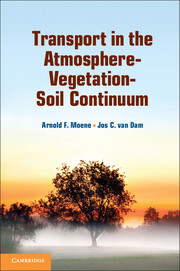Book contents
- Frontmatter
- Contents
- Preface
- 1 The Atmosphere-Vegetation-Soil System
- 2 Available Energy: Net Radiation and Soil Heat Flux
- 3 Turbulent Transport in the Atmospheric Surface Layer
- 4 Soil Water Flow
- 5 Solute Transport in Soil
- 6 Vegetation: Transport Processes Inside and Outside of Plants
- 7 Combination Methods for Turbulent Fluxes
- 8 Integrated Applications
- 9 Integrated Models in Hydrology and Meteorology
- Appendix A Radiation
- Appendix B Thermodynamics and Water Vapour
- Appendix C Dimensional Analysis
- Appendix D Microscopic Root Water Uptake
- Appendix E Crop Factors for Use with Makkink Reference Evapotranspiration
- Answers
- List of Main Symbols
- References
- Index
4 - Soil Water Flow
Published online by Cambridge University Press: 05 June 2014
- Frontmatter
- Contents
- Preface
- 1 The Atmosphere-Vegetation-Soil System
- 2 Available Energy: Net Radiation and Soil Heat Flux
- 3 Turbulent Transport in the Atmospheric Surface Layer
- 4 Soil Water Flow
- 5 Solute Transport in Soil
- 6 Vegetation: Transport Processes Inside and Outside of Plants
- 7 Combination Methods for Turbulent Fluxes
- 8 Integrated Applications
- 9 Integrated Models in Hydrology and Meteorology
- Appendix A Radiation
- Appendix B Thermodynamics and Water Vapour
- Appendix C Dimensional Analysis
- Appendix D Microscopic Root Water Uptake
- Appendix E Crop Factors for Use with Makkink Reference Evapotranspiration
- Answers
- List of Main Symbols
- References
- Index
Summary
Introduction
Compared to the height of the atmosphere, the depth of the ocean and the thickness of Earth’s crust, the permeable soil above the bedrock is an amazingly thin body – typically not much more than a few metres and often less than 1 m. Yet this thin layer of soil is indispensable to sustain terrestrial life. Soil contains a rich mix of mineral particles, organic matter, gases, and soluble compounds. When infused with water, soil constitutes a substrate for the initiation and maintenance of plant and animal life. Precipitation falls intermittently and irregularly, although plants require a continuous supply of water to meet their evaporative demand. The ability of soil to retain soil moisture (and nutrients) is crucial for vegetation to overcome drought periods. Soil determines the fate of rainfall and snowfall reaching the ground surface – whether the water thus received will flow over the land as runoff, causing floods, or percolate downward to the subsurface reservoir called groundwater, which in turn maintains the steady flow of springs and streams. The volume of moisture retained in the soil at any time, though seemingly small, greatly exceeds the volume in all the world’s rivers (Hillel, 1998). Without the soil, rain falling over the continents would run off immediately, producing devastating floods, rather than sustaining stream flow. The normally loose and porous condition of the soil allows plant roots to penetrate and develop within it so as to obtain anchorage and nutrition, and to extract stored moisture during dry spells between rains. But the soil is a leaky reservoir, which loses water downward by seepage and upward by evaporation. Managing the top system in water deficit regions so as to ensure the survival of native vegetation as well as to maximize water productivity by crops requires monitoring the water balance and the consequent change of moisture storage (as well as nutrient storage) in the root zone (Hillel, 1998). Soil regulates the amount of evapotranspiration, which is with rainfall the largest component of the hydrological cycle. In weather prediction, climate and environmental research and groundwater recharge, the amount of evapotranspiration plays a key role. Therefore not only a qualitative understanding of the soil water flow mechanisms is required, but also a precise quantitative knowledge of these processes.
- Type
- Chapter
- Information
- Transport in the Atmosphere-Vegetation-Soil Continuum , pp. 133 - 176Publisher: Cambridge University PressPrint publication year: 2014



